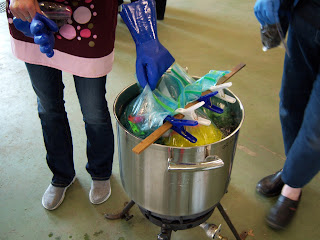Teaching Level 4 was a new experience for me. I teach beginners. That's my thing. I love coaxing novices down the rabbit hole that is the spinning world, or any new world, for that matter. I was nervous about moving away from my fledglings and towards advanced students, but everyone was patient and kind and once again, I found myself working with a great group of people. "Working with" is the operative phrase - many of these students know at least as much as the instructor about certain topics. Student occupations outside the spinning world run the gamut from project managers, mathematicians, artists, farmers to journalism majors. I'm learning that the trick to teaching upper levels is to step back, to utilize everyone's talents and to allow the students to tell me a thing or two or three.
Excellent math skills came in handy on Dye Day, when the assignment was Percentage Dyeing with acid dyes. By the end of day, the chart of percentage calculations on the board was a work of art. I couldn't get a decent photo of it because my camera didn't like the poor lighting in the machine shop, but this will give you some idea of the work involved:
By the end of day, the board was covered in calculations for each colour dyed, weights of fibres, stock solutions and the amounts of dye solution required for each colour. One of the assignments was to dye a 12 step colour wheel; one of the teams expanded that to 24 steps. Another group played with ombre and injection dyeing. The last assignment of the day was Rainbow Dyeing on fleece, which involves stuffing raw wool into a dye pot with some water and vinegar, sprinkling dye powders and top and then walking away with poking at the mix. The colours for that were fantastic; I am looking forward to stuffing a pot of my own.
 |
| Tending the pot |
 |
| Jennifer with some of her skeins |
We were fortunate this year to have two renowned silk reeling experts on campus - Michael Cook aka Wormspit and Coleen Nimetz, my travelling companion and the Level 6 instructor. Michael was our roomie. Most of the time, I sat in our townhouse with my mouth hanging open, as he and Coleen discussed the technical details of various silk moths and the fibres they produce. When Michael explained something to me by quoting a phrase in Latin, I knew I was out of my league. When he pulled out his tablet woven band with that same quotation woven into the pattern, I was done. (Old style Catholic masses and high school Latin classes just weren't enough to keep up.) I was toast and I knew it, but Michael is a friendly, gentle person who shared his knowledge generously. Both he and Coleen invited me to observe their reeling classes; Coleen kindly allowed my class to observe her Level 6 reeling. (I was happy about this because I've reeled silk three times in my life; once with Michael in a mini-workshop and twice with Coleen. Silk reeling is not applicable to tapestry weaving, at least not the tapestry weaving I do.) Because we had access to the experts, I had planned to skip the hands-on demonstration in class, but it became apparent that this would be a mistake, so I turned the assignment over to the students who did a wonderful job at reeling despite having a less than cooperative crock pot, makeshift equipment and a teacher (me) who was clueless in the art of silk reeling:
As always, the Olds Campus grounds are beautiful. I visited my poppy beds:
A large Raven was nesting on top of the veterinary clinic on campus and protested loudly every time I walked by. On the last day we had a lengthy conversation, as she squawked at me and I squawked back. (I hope no one saw me, because I'm sure I appeared quite mad.) She would not allow me to take her picture.
The evening light at Olds confuses me every year. Olds is not that far north of my home, but it stays much lighter in the town than it does back in Regina. Here's a shot from our townhouse, taken at 9:43 p.m. on Wednesday evening. It's no wonder I can never sleep at Fibre Week:
That's it for another year. Thanks to everyone who made it such a wonderful experience, yet again. A big "Thank You" to my class, Level 4, 2015:
For fellow spider aficionados, I leave you with the video of a dancing Peacock Spider, courtesy of Michael Cook:
Namaste.













